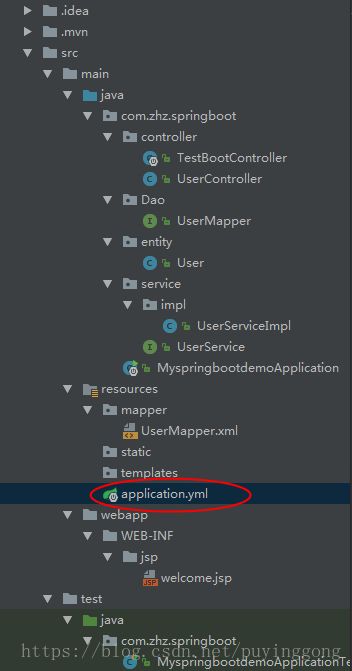创建一个springboot+mybatis的项目
创建基础的 spring boot项目就不说了,参考上一个文章:
https://blog.csdn.net/puyinggong/article/details/80653014
一、添加对应的pom文件
mysql
mysql-connector-java
runtime
com.alibaba
druid
1.1.0
第一个主要是为了添加mysql的包支持,当然这个也根据项目情况,也可以添加oracle的,等到
第二个主要是为了添加数据库连接池,这个是阿里开发的开源项目,当然还有很多功能
具体参考:https://www.cnblogs.com/niejunlei/p/5977895.html
二、生成对应代码和sql映射文件
然后就是创建对应的实体类啦,这个没什么好说的,大家都知道。
我创建了大概的几个类和sql映射
需要注意的是,UserServiceImpl这个类需要用到类注解
@Service("userService")
控制层代码如下:
package com.zhz.springboot.controller;
import com.zhz.springboot.entity.User;
import com.zhz.springboot.service.UserService;
import org.springframework.stereotype.Controller;
import org.springframework.ui.Model;
import org.springframework.web.bind.annotation.RequestMapping;
import org.springframework.web.bind.annotation.ResponseBody;
import javax.annotation.Resource;
import javax.servlet.http.HttpServletRequest;
@Controller
@RequestMapping("/user")
public class UserController {
@Resource
private UserService userService;
@RequestMapping("/showUser")
@ResponseBody
public User toIndex(HttpServletRequest request, Model model){
int userId = Integer.parseInt(request.getParameter("id"));
User user = this.userService.getUserById(userId);
return user;
}
}
接口层代码如下:
package com.zhz.springboot.Dao;
import java.util.List;
import com.zhz.springboot.entity.User;
import org.apache.ibatis.annotations.Param;
public interface UserMapper {
int deleteByPrimaryKey(Integer userId);
int insert(User record);
int insertSelective(User record);
User selectByPrimaryKey(Integer userId);
int updateByPrimaryKeySelective(User record);
int updateByPrimaryKey(User record);
/**
* 查询用户信息并分页
* @param skip
* @param size
* @return
*/
public List queryUserPager(@Param("skip") int skip,@Param("size") int size);
/**
* 查询用户总数
* @return
*/
public int queryUserCount();
/**
* 删除多个用户
* @param userIds
* @return
*/
public int deleteUsers(int[] userIds);
} sql映射文件如下:
user_id, user_name, user_sex, user_birthday, user_email, user_edu, user_telephone,
user_address, create_time
delete from tb_user where user_id in
#{item}
delete from tb_user
where user_id = #{userId,jdbcType=INTEGER}
insert into tb_user ( user_name, user_sex,
user_birthday, user_email, user_edu,
user_telephone, user_address, create_time
)
values ( #{userName,jdbcType=VARCHAR}, #{userSex,jdbcType=VARCHAR},
#{userBirthday,jdbcType=DATE}, #{userEmail,jdbcType=VARCHAR}, #{userEdu,jdbcType=VARCHAR},
#{userTelephone,jdbcType=VARCHAR}, #{userAddress,jdbcType=VARCHAR}, #{createTime,jdbcType=TIMESTAMP}
)
insert into tb_user
user_name,
user_sex,
user_birthday,
user_email,
user_edu,
user_telephone,
user_address,
create_time,
#{userId,jdbcType=INTEGER},
#{userName,jdbcType=VARCHAR},
#{userSex,jdbcType=VARCHAR},
#{userBirthday,jdbcType=DATE},
#{userEmail,jdbcType=VARCHAR},
#{userEdu,jdbcType=VARCHAR},
#{userTelephone,jdbcType=VARCHAR},
#{userAddress,jdbcType=VARCHAR},
#{createTime,jdbcType=TIMESTAMP},
update tb_user
user_name = #{userName,jdbcType=VARCHAR},
user_sex = #{userSex,jdbcType=VARCHAR},
user_birthday = #{userBirthday,jdbcType=DATE},
user_email = #{userEmail,jdbcType=VARCHAR},
user_edu = #{userEdu,jdbcType=VARCHAR},
user_telephone = #{userTelephone,jdbcType=VARCHAR},
user_address = #{userAddress,jdbcType=VARCHAR},
create_time = #{createTime,jdbcType=TIMESTAMP},
where user_id = #{userId,jdbcType=INTEGER}
update tb_user
set user_name = #{userName,jdbcType=VARCHAR},
user_sex = #{userSex,jdbcType=VARCHAR},
user_birthday = #{userBirthday,jdbcType=DATE},
user_email = #{userEmail,jdbcType=VARCHAR},
user_edu = #{userEdu,jdbcType=VARCHAR},
user_telephone = #{userTelephone,jdbcType=VARCHAR},
user_address = #{userAddress,jdbcType=VARCHAR},
create_time = #{createTime,jdbcType=TIMESTAMP}
where user_id = #{userId,jdbcType=INTEGER}
方便的,还是建议写个自动生成的,使用
MybatisGenerator
自己写个项目,导入依赖包,平时只要使用的时候,改下配置文件,运行main方法自动生成,然后拷贝到自己项目中,还是很方便的。
这些都完成了,那么下一步就是关键了,就是怎样让这些东西都能生效呢。
三、添加配置文件,使mybatis生效
在resources文件夹下面创建配置文件,application.yml,然后里面添加对应的配置信息
#公共配置与profiles选择无关 mapperLocations指的路径是src/main/resources
mybatis:
typeAliasesPackage: com.zhz.springboot.entity
mapperLocations: classpath:mapper/*.xml
#开发配置
spring:
profiles: dev
datasource:
url: jdbc:mysql://localhost:3306/test
username: root
password: 123456
driver-class-name: com.mysql.jdbc.Driver
# 使用druid数据源
type: com.alibaba.druid.pool.DruidDataSource
# 连接池设置
druid:
initial-size: 5
min-idle: 5
max-active: 20
# 配置获取连接等待超时的时间
max-wait: 60000
# 配置间隔多久才进行一次检测,检测需要关闭的空闲连接,单位是毫秒
time-between-eviction-runs-millis: 60000
# 配置一个连接在池中最小生存的时间,单位是毫秒
min-evictable-idle-time-millis: 300000
# Oracle请使用select 1 from dual
validation-query: SELECT 'x'
test-while-idle: true
test-on-borrow: false
test-on-return: false
# 打开PSCache,并且指定每个连接上PSCache的大小
pool-prepared-statements: true
max-pool-prepared-statement-per-connection-size: 20
# 配置监控统计拦截的filters,去掉后监控界面sql无法统计,'wall'用于防火墙
filters: stat,wall,slf4j
# 通过connectProperties属性来打开mergeSql功能;慢SQL记录
connection-properties: druid.stat.mergeSql=true;druid.stat.slowSqlMillis=5000
# 合并多个DruidDataSource的监控数据
use-global-data-source-stat: true
mvc:
view:
prefix: /WEB-INF/jsp/
suffix: .jspOK,到这一步,整个配置就完成了,是不是很简单,方便了太多太多,节约了大部分配置。
然后回到man方法,启动整个项目。
输入对应地址
localhost:8080/user/showUser?id=1
浏览器展示从数据获取的值,测试成功。

